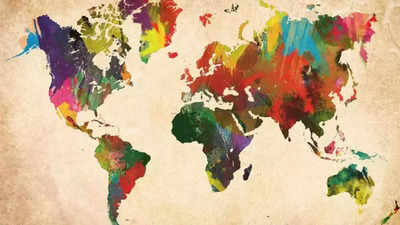Countries around the world often receive nicknames that succinctly capture their unique identities, reflecting elements of their history, geography, or culture. These informal titles serve as shorthand references that convey a wealth of information and context in just a few words. Here's an overview of how these nicknames are formed and what they represent.
Nicknames frequently have historical origins, reflecting pivotal events or cultural milestones. For example, Japan’s "Land of the Rising Sun" references its geographic location east of the Asian continent, symbolising new beginnings. Geographical attributes can significantly influence a country’s nickname.

Iceland is "Land of Fire and Ice" and highlights its volcanic and glacial landscapes. These nicknames often emphasise distinctive physical features. Cultural stereotypes and perceptions also play a role in shaping nicknames.
Canada’s "The Great White North" reflects its snowy climate and northern location, showcasing how cultural views contribute to a nation’s identity. Media and popular culture frequently contribute to country nicknames. For instance, Thailand’s "Land of Smiles" comes from its reputation for friendliness and warmth, as highlighted in travel literature and media.
Local vernacular and expressions can give rise to unique nicknames. For example, "The Emerald Isle" for Ireland alludes to its lush green landscapes and cultural heritage, rooted in local language and traditions. Cuba's nickname, "Sugar Bowl of the World," highlights its historical and economic significance as one of the world's leading producers of sugar.
This emphasises the island's crucial role in the global sugar industry. "Gift of the Nile" refers to the essential role of the Nile River in shaping Egypt's civilization. The river's annual floods provided fertile soil, which was fundamental to Egypt's agricultural success and the development of its ancient society.
Finland is aptly named "Land of a Thousand Lakes" due to its extensive number of lakes—over 188,000. This nickname underscores the country's rich natural landscapes and its scenic, lake-filled terrain. The nickname "Land of Golden Fleece" is a nod to Australia's historical sheep farming industry, which was once a major economic driver.
It reflects the country's association with wool production and its early colonial history. "Land of the Long White Cloud" is a translation of the Māori name for New Zealand, Aotearoa. The nickname describes the country’s often cloud-covered landscapes and its misty, mountainous regions.
Thailand's dual nicknames reflect its cultural heritage and hospitality. "Land of White Elephants" refers to the rare and sacred white elephants traditionally associated with Thai royalty. "Land of Smiles" emphasises the friendly and welcoming nature of its people.
The term "Cockpit of Europe" alludes to Belgium's central location in Europe and its history of being a battleground during European conflicts. It signifies Belgium's strategic geopolitical importance. This nickname, popularised by the patriotic song "Land of Hope and Glory," captures England's historical and cultural significance, as well as its sense of national pride and aspirations.
"Playground of Europe" highlights Switzerland's reputation as a premier destination for outdoor sports and leisure. "Land of Milk and Honey" reflects its high quality of life, prosperity, and beautiful landscapes. "Rainbow Nation" is a term coined by Archbishop Desmond Tutu to describe South Africa's diverse population and its transition to democracy post-apartheid.
It symbolises the country's unity in diversity. Norway's nickname "Land of the Midnight Sun" refers to the natural phenomenon where the sun remains visible at midnight during the summer months above the Arctic Circle, showcasing its unique geographical features. Japan is often called the "Land of the Rising Sun" because of its geographical position to the east of the Asian continent.
The nickname reflects Japan's cultural symbolism of the sunrise and its historical significance. "Land of the Thunderbolt" refers to Bhutan's traditional symbol of the thunderbolt (or "Dorje"), which represents the power of Tibetan Buddhism and the country’s spiritual heritage. "Land of the Morning Calm" reflects South Korea's serene landscapes and tranquil mornings, emphasising the peaceful and scenic nature of the country.
The nickname "Hermit Kingdom" denotes North Korea's isolationist policies and its relative secrecy from the outside world, highlighting its limited engagement with international affairs. Myanmar's nickname "Land of the Golden Pagoda" refers to its numerous and famous golden pagodas, including the Shwedagon Pagoda, which are significant symbols of the country's Buddhist culture. "The Red Dragon" symbolises China's historical and cultural association with the dragon, a revered figure in Chinese mythology.
"The Midlands" reflects the country's central position in East Asia. Indonesia is called "The Emerald of the Equator" due to its lush, green landscapes and its equatorial location, which contributes to its rich biodiversity and tropical beauty. "Ireland: The Emerald Isle" highlights the country's verdant landscapes and rolling green hills, which are a defining feature of its picturesque scenery.
"The Boot" refers to Italy’s distinctive shape on the map, resembling a high-heeled boot. This nickname vividly illustrates the country's geographical outline. The nickname "The Pearl of the Orient Seas" emphasises the Philippines' natural beauty and its valuable resources, as well as its position in Southeast Asia.
Mongolia is known as "Land of the Blue Sky" due to its vast, open skies and clear weather conditions, reflecting the country's expansive and unspoiled landscapes. "Iceland: Land of Fire and Ice" captures the country’s dramatic natural features, including its volcanic activity and glacial landscapes, showcasing its geothermal and icy contrasts. "India’s Teardrop" refers to Sri Lanka’s geographical location off the southeastern coast of India, resembling a teardrop in its position relative to the Indian subcontinent.
The nickname "Graveyard of Empires" highlights Afghanistan's historical reputation as a challenging terrain for foreign powers attempting to conquer it, reflecting its complex and tumultuous history. "Switzerland of the Middle East" underscores Lebanon's historical reputation for financial services and its relatively stable and scenic mountainous terrain compared to its regional neighbours. "Land of the Upright Men" is a translation of the country's name in the local language, reflecting the dignity and integrity of its people.
Madagascar is often called "The Red Island" due to its distinctive red soil, which is a prominent feature of its landscape. "Land of a Thousand Hills" refers to Rwanda's hilly terrain and mountainous landscape, which characterise its geographical and scenic beauty. "Pindorama" is an indigenous term meaning "Land of the Palms," reflecting Brazil's abundant palm trees and tropical environment.
"The Great White North" highlights Canada’s vast and snowy landscapes, particularly its northern regions known for their cold winters and extensive natural beauty. "Land of Poets" celebrates Chile’s rich literary heritage and its notable poets, including Pablo Neruda and Gabriela Mistral, who have earned the country recognition in the literary world. "Land of Many Waters" refers to Guyana’s numerous rivers, waterfalls, and lakes, highlighting its rich aquatic resources and lush environment.
"Land of the Incas" acknowledges Peru’s historical and cultural connection to the Inca Empire, emphasising its significant archaeological and historical heritage. The USA is known by various nicknames: "Uncle Sam" symbolises the nation's persona, "The States" denotes its political structure, and "The Land of Opportunity" reflects its reputation as a land of potential and prosperity. "Land of Grace" reflects Venezuela’s picturesque landscapes and the gracefulness of its natural beauty.
"Land of Eagles" is a reference to the eagle, a symbol in the country’s national emblem, representing strength and freedom. "The White Rus" refers to Belarus’s historical and cultural ties to the broader Rus' region, highlighting its place in Eastern European history. "The Red Basket of Europe" emphasises Ukraine’s historical role as a major agricultural producer, particularly in grain production.
"The Land of Noah" is a reference to the biblical tradition that Noah’s Ark landed on Mount Ararat, which is located in Armenia, connecting the country to this significant biblical narrative. This nickname reflects Bhutan’s cultural heritage and its connection to Tibetan Buddhism, where the thunder dragon is a powerful symbol. India is known as "The Golden Sparrow" for its historical wealth and prosperity, and "The Subcontinent" reflects its large and diverse geographical and cultural presence in South Asia.
"Land of ShipBuilders" highlights Singapore’s historical role as a major hub for maritime trade and shipbuilding, which has contributed to its development as a global financial centre. "The Hinge of Africa" denotes Cameroon’s central position in Africa, acting as a bridge between different regions of the continent. "Gem of Africa" reflects Namibia’s stunning landscapes and natural beauty, which make it a prized destination in Africa.
"Pearl of Africa" celebrates Uganda’s diverse landscapes and rich biodiversity, emphasising its natural beauty and ecological significance. "Roof of the World" refers to Tibet's high elevation, as it is situated on the Tibetan Plateau, the highest region on Earth. "The Bull Skin" relates to Spain’s bullfighting tradition, while "The Land of Cervantes" honours the famed writer Miguel de Cervantes.
"Land Between Two Rivers" refers to Mesopotamia, an ancient region located between the Tigris and Euphrates rivers, highlighting Iraq’s historical and geographical significance. Explore the architectural wonders of the world 2024: Captivate your heart with the iconic marvels.



















